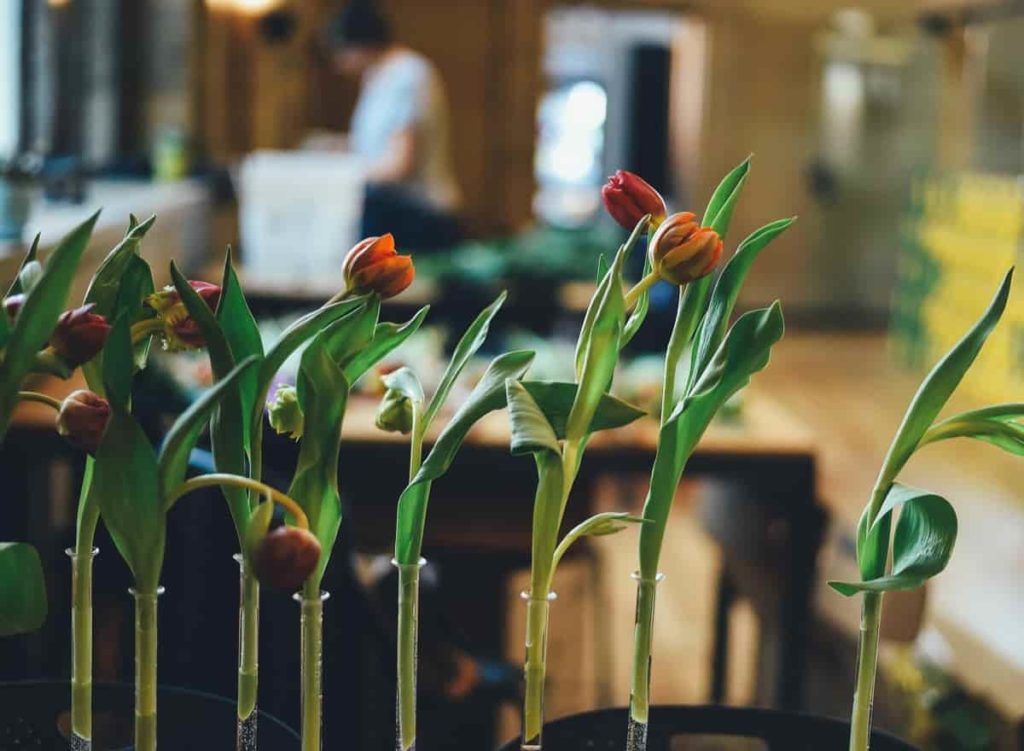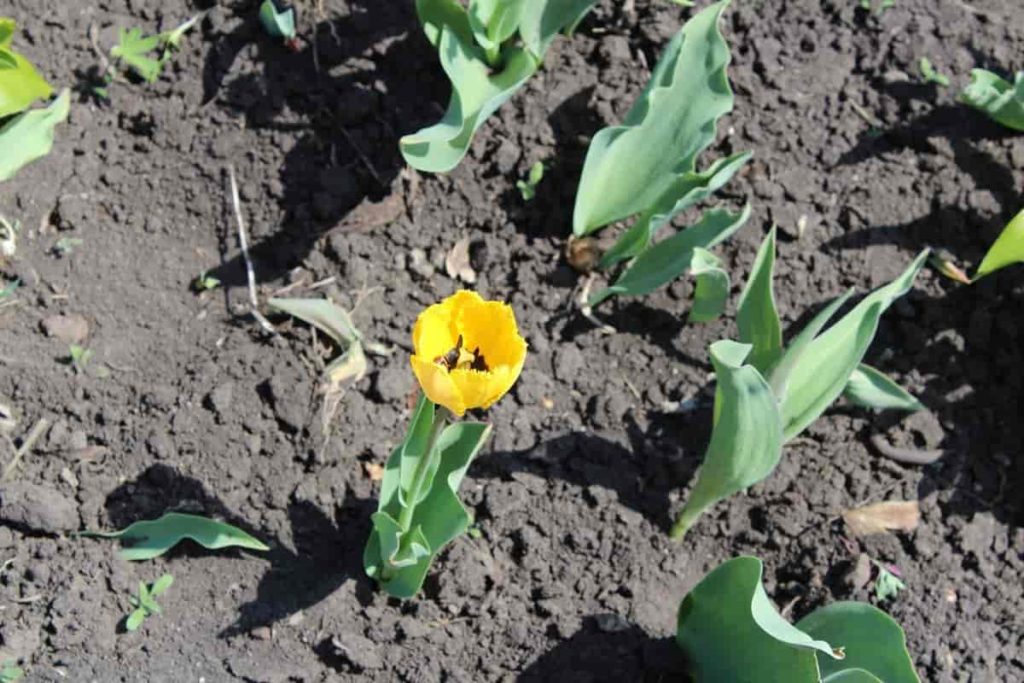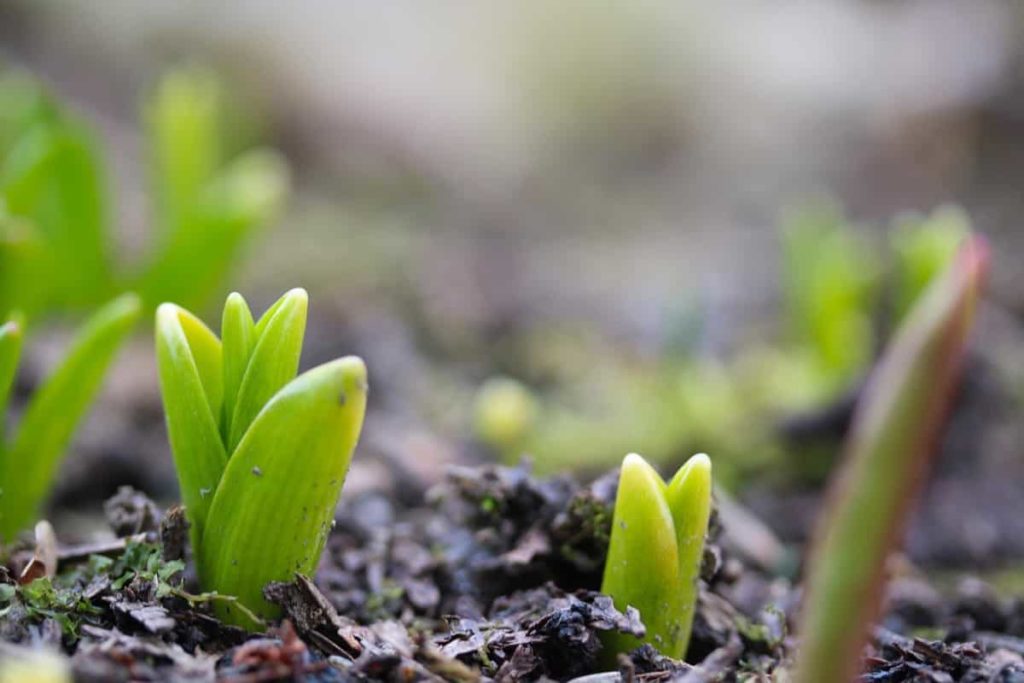Every type of Tulip is grown from bulbs. These bulbs and corms require the consistency of specific soil to grow. So, the soil should be light and sandy for the Tulip bulb. It should be healthy, nutritious, and well drained. Plant the Tulip bulbs in the full sun if possible. This will help your Tulips achieve their maximum height and flower size. Let’s check out how to prepare the soil for Tulip plants below.

The Tulips perform well in half-day sun and also beneath deciduous trees. In a warm climate, flowers will last longer if they are protected from the hot afternoon sun. The best thing about the Tulip is that they don’t need much nutrition as other garden plants. Tulips grow in sandy, rocky soil in the mountainous region. It is very low to maintain nutrition and moisture in these soil conditions.
The Tulip bulbs can store nutrition and water for long to overcome such harsh conditions. These flowering bulbs require minerals like calcium and magnesium that they can obtain from the soil. Almost every type of Tulip requires soft sandy or loamy soil. You can use soil to grow the Tulip, although you must add sand and cocopeat to improve drainage.
The Tulip does not require much nutrition to grow and bloom. Still, it’s better to add enough organic matter that can feed the Tulip bulb in its life cycle. There is no need to fertilize the Tulip plants, especially if the soil contains enough nitrogen, phosphorus, potassium, calcium, and magnesium.
How to prepare the soil for Tulip plants
Soil pH for Tulip
Soil acidity is essential when growing the Tulip, which prefers neutral over slightly acidic soil. The ideal soil pH for the Tulip plant is 6.0 to 7.0. However, a Tulip plant can survive in soil with a pH of 5.5 to 7.3. Using a little acidic soil to grow the Tulips is always better. Due to the long application of chemical salt fertilizers, container soil is usually alkaline.
For container Tulips, you can use soil with a pH of 5.5. If the soil is alkaline, add acidic mulch and soil modifications such as peat moss, pine needles, shredded oak leaves, and animal manure. Adding wood ash draws acid soil closer to a neutral composition.
In case you missed it: Growing Tulips Indoors from Seed in Pots, Containers

Preparation of soil for growing Tulip on grounds
Although Tulips can grow in almost any kind of soil, they prefer sandy soil sand filled with organic material. The Tulips do not grow well in clay soil. The best soil for bulbs will be loose and airy. Add organic material to improve the structure of heavy soil. Loosen the soil under the plantation area to encourage the roots to spread. The Tulip benefit from bone meal embedded in loose soil under the bulbs.
Although the Tulips are some of the best flowers to plant in spring, wet conditions at this time of year can prove challenging. To deal with this, modify the soil with chopped pine bark or sand to improve the drainage properties. Another option for a poor drainage site is to plant a Tulip bulb in a raised bed full of good soil. Mixing the compost can improve drainage and provide nutrients to bulbs. Ideally, do this before planting the bulb.
Preparation of soil for growing Tulip in a pot
You must fill your chosen container with rich potting soil. You can use high-quality potting soil; the better the chance your Tulips have to survive. The reason why soil quality is so important is that healthy soil can store and process more water. Poor quality soil, on the other hand, cannot hold so much water, making it impossible for your new plants to grow, thrive, and survive. Healthy, high-quality soil sits in the abundance of organic matter, including living organisms, which promote good plant health.
Perlite and vermiculite potting mixtures are the best mediums for Tulips. Work outside and carefully pours a bag of potting mix into the pot. Place the bulbs first against the inner edge of the pot, then move your way to the center of the pot. Push the flat part of the bulbs deep enough into the soil to hold them in place. If you are crowding the bulbs, give water and apply fertilizer regularly.
If you want your Tulips to be of different heights or want more Tulips in your pots, you can layer bulbs over each other. To do this, cover the upper coating of bulbs with 1 to 2 inches of soil, then plant another coating over the first coating before they are covered with potting soil. When the bulbs open, they will fill the whole pot.
Cover the upper surface of the bulbs with 5 to 8 inches of soil. You can apply the second layers of bulbs directly to the first layers. If you don’t want to change the soil every year, use a standard potting mix with compost and fertilize it throughout the year. You must dress up the top of the soil with compost before the growing season.
How to grow Tulip in clay soil
The Tulips don’t like the soggy ground as it will rot their bulb. If you suspect the drainage is bad, try digging a foot hole and filling it with water. Look at it, and if you can see that it takes a long time for the water to disappear, you have poor drainage. Add coarse sand or peat moss for clay-based soil before planting Tulip bulbs. This helps in improving drainage. Plant Tulips bulbs about 6 to 8 inches deep, measuring from the bulb’s base.
In case you missed it: How to Prepare the Soil for Rose Plants: Best Soil Mix, pH, Compost, and Recipe

If you add mulch after planting, add it as part of the depth of your overall plantation. In addition to good drainage, Tulips like quite loose soil. Although they will grow in clay soil, sustaining themselves yearly in heavy soil is difficult. You should prepare your ground with compost and peat moss for a long, large Tulip. The Tulips are strong and compete with surprisingly poor soil, but they will be smaller and less vigorous.
Soil composting for Tulip
If you are planning to grow a Tulip in your garden, you need to ensure that the soil’s clay content is low to avoid the problem of poor drainage. The Tulip doesn’t like to sit in water, so if the soil content is higher than the sand in the soil, it will keep water for a long time, affecting its health.
If you can, it’s a good idea to add organic matter to the soil before planting the Tulip because it will improve both the sandy and the clay soil, making them more suitable. If your soil is deficient in nutrients, add chicken manure pellets. Moreover, alkaline soil is the perfect environment for Tulips, and it is a good idea to add lime to the soil with a pH below 6.5.
Land preparation for Tulip
A Tulip plant needs at least 4 to 6 inches of deep soil. You can even plant bulbs at a depth of 8 to 10 inches, especially in hot, dry climates. Soil depth helps the bulb to stay safe and protected from external factors. Heatwaves, frequent frosts, heavy rain or snowfall, and cold air can damage exposed Tulip bulbs. So, growing a flat 4 to 6 inches of soil-deep erased Tulips is better. You should consider soil density and bulb size to determine the depth of the soil.
You should plant large 3 to 5-inch bulbs deeper than small one or 2-inch diameter bulbs. In addition, the soil should be soft and light to keep the bulbs deep. Dig the area and loosen the soil to about 30 centimeters. After preparing the site for the Tulip, dig the planting holes. You must dig each hole three times the length of the Tulip bulb. Soil, twice the bulb’s height, should be at the tip of the bulb.
If they are planted in borders, bulbs must be planted in groups of ten and accommodated about 5 centimeters or a couple of inches apart. It is important to face the pointy end of the bulb. After planting the bulbs, water them thoroughly and cover the area with pine bark or a mulch made of chopped leaves to protect it from insects and harmful elements.
Best soil mix for Tulip
- Mix 30% compost with 30% garden soil, 20% cocopeat, and 20% sand. This is the easiest soil mixture of Tulip plants. This soil mixture does not become soggy even in heavy rain or water. So, the chances of root rot are very low due to water logging.
- Add 25% garden soil with 30% compost, 20% sand, 10% cocopeat, 5% bone meal, 5% mustard cake powder, 2% superphosphate, 2% potash, 1% systemic or contact fungicides. This combination is successfully tested 100% in 17 different Tulip types; you can play with percentage if you want.
In case you missed it: 15 Common Hibiscus Plant Problems: How to Fix Them, Solutions, and Treatmentbis

Natural soil amendments for growing Tulip
You can amend the soil with some material to help the Tulips to grow well. Some essential nutrients can help us get bigger flowers, while others can help in development. Appropriate amendments can also help the plant fight pest attacks. You can add sand to increase drainage. Cocopeat and compost can increase moisture retention and slowly fertilize the soil. Bone meal is useful in feeding the Tulip bulbs.
It gradually releases potassium, phosphorus, calcium, magnesium, and sulfur to strengthen the root system. The perlite can lose the consistency of the soil and increase moisture retention. Superphosphate is a supplement salt to increase phosphorus levels for early blooming. Potash is a compound of potassium salt for better root and bud growth. Mustard cake powder is an organic alternative to balanced flower food. Wood ash can help control pests and increase soil pH levels.
Mulching is done with straw to keep the soil cool. Mulching is done immediately after cultivation in mild winter areas while waiting 3 to 4 weeks after planting before mulching to allow the roots to grow slightly before freezing the ground in cold winter. The common fertilizer for fertilizing flowers is dry coffee grounds. You can easily add waste products to the soil layers above.
Coffee grounds contain nitrogen and also contain phosphorus and potassium. However, you should not fertilize your Tulips frequently with coffee grounds, as this will reduce the soil’s pH level in the acidic range in the long run. You can use wood ash as fertilizer for your Tulip. It is rich in potassium but includes lime and other important trace elements. The use of wood ash also helps in counteract fungal diseases and rot in the soil.
What to do with soil when growing Tulip
Forget me not having bright green leaves with small, cloud-shaped blue flowers. They grow abundantly up to a partial shade under the full sun. This flower can create a perfect floral carpet design in your garden when grown with a Tulip. More or their needs are similar to those of Tulips; when planted with the Tulip, they will create a perfect comfortable backdrop for the Tulips in your garden.
In case you missed it: How to Start a Terrace Garden from Scratch in Bangalore/Karnataka: for Vegetables, Flowers, Herbs, and Fruits

Alliums are bulb plants, like Tulips. Their leaves resemble the size of the leaves of the Tulips. These plants will bloom a few weeks after the Tulip is done blooming. Even if the blooms and leaves of the Tulip fade and die, these plants will flower and save your garden a gentle look. Snowdrops are the best perennial ones with low green leaves and white flowers. They are going to resist drought.
So, you will protect your Tulip bulb from rotting. When your Tulip leaves die and turn yellow, their leaves remain green. As both the Tulips and Snowdrops have the same leaves, they can hide the dying Tulip leaves, and it will still make your garden green. Grape Hyacinth is another flowering plant; they look pleasant when paired with Tulips. When planted between the Tulips, their small flowers will decorate the landscape. They will return every year during spring. Growing a Hyacinth with a Tulip will encourage good pollination in both plants.
Like the Tulips, the Bleeding Heart also enjoys growing in the same moist soil. You can add mulch to help plants absorb excess water and maintain moisture. When the mulch breaks into the soil, the soil bed will become fertile. Both flowers would love to stand on fertile soil. Generally, Sage is an herb found in most homes and gardens. They are known to stop their repelling abilities. Sage will create a fantastic setting for the Tulip as they have beautiful blue to purple flowers and green leaves.
When the Tulip flowers and leaves die, the green leaves of the Sage will make your garden neat and clean instead of looking dull and famishing. Although Sage likes neutral soil, the ideal slight acidic shape for the Tulip won’t damage them much. Growing Sage with a Tulip is pest resistance. Pests and insects will hate the smell of Sage. So, you will protect your Tulips from all kinds of insects. Columbine is a great companion for the Tulip due to their similar features and color contrast with the Tulip.
In case you missed it: Growing Organic Lavender – In Pots, And Containers

Columbine has different colors. They have a lot of colors like bright red, yellow, orange, purple, and color combinations. They need full sun, neutral soil, and equally moist, well-drained soil like the Tulip. After planting Columbine in the early fall, you need to plant the bulb immediately. Both of them will flower in spring. But when the Tulips die after spring, Columbine will flower till summer. So, these will be beautiful columbines after the Tulips in your garden.
Conclusion
The Tulips love soil with good drainage, which can keep enough moisture directly in the sunlight. Add plenty of sandy soil, growing your Tulips in your garden. Always maintain a soil pH as neutral. Prune dead and old flowers to encourage the Tulips to bloom more. When the sun is too harsh, mulch the surface to protect the plants from extreme heat and keep the soil moist. By following above mentioned soil preparation tips and taking care of your bulbs, you can enjoy beautiful Tulip flowers.
- How to Grow Hibiscus from Flower
- Plantation Ideas for Home Decoration: A Beginners Guide
- Flower Garden Designs and Layouts for Beginners
- Planting and Spacing Techniques in Papaya: A Beginner’s Guide
- Growing Gold: Essential Techniques for Planting Pineapples
- How to Make Kalanchoe Plant Bushy: Home Remedies and Solutions
- 11 Reasons Why Your Gardenia is Not Blooming: Home Remedies and Solutions
- Eco Elegance: The Guide to Designing a Drought-Tolerant Landscape
- Gardening on a Slope: Strategies for Hillside Landscaping
- Nourish and Flourish: Top Organic Mulches for Thriving House Plants
- Everything You Want to Know about Indian Mogra Flower: Discover Uses and Growing
- Green Thumb Success: Expert Tips for Cultivating Greenhouse Pumpkins All Year Round
- Maximize Growth & Flavor: The Ultimate Guide to Companion Planting in Herb Gardens
- How to Control Rhododendron Problems Naturally: Home Remedies and Organic Ways to Fix Them
- Natural Magic: The Remarkable Benefits of Cinnamon for Plants
- Best Steps to Revive Dying Tulip with Natural and Organic Treatment
- 10 Reasons Why Your Angel Trumpet is Not Blooming: Remedies and Treatment
- How to Fix Periwinkle Leaf and Flower-Related Problems: Natural Remedies and Solutions
- How to Fix Zinnias Leaf and Flower Problems: Discover Natural and Home Remedies
- Organic Steps to Induce Lemon Tree Flowers: A Comprehensive Guide
- Bloom Booster: Crafting the Perfect Homemade Bougainvillea Fertilizer
- Optimizing Growth: A Guide to Applying NPK Fertilizer for Potted Plants
- 10 Best Homemade Fertilizers for Rubber Plant: DIY Recipes and Application Method
- How to Boost Female Pumpkin Flowers: Effective Steps for More Flowers and High Yields
- Transform Your Indoor Garden: Top Benefits of Pink Salt for Houseplants
- 10 Best Homemade Fertilizers for Peacock Plants (Calathea): Easy DIY Guide
- Unlock Blooms: 9 Reasons Why Your Potted Chrysanthemum is Not Blooming
- 8 Reasons Why Your Potted Hibiscus is Not Blooming: Fix it with Simple Solutions
- Unlock Blooms: 9 Key Reasons Your Potted Frangipani Won’t Flower
- 10 Reasons Why Is My Ice Plant Not Blooming: Remedies and Treatment
- 10 Reasons Why My Potted Hydrangea Not Blooming: Treatment and Remedies
- 10 Reasons Why is My Wisteria Not Blooming: Remedies and Treatment
- 10 Reasons Why is My Goldfish Plant Not Blooming: Remedies and Treatment
- Maximize Your Space: Ultimate Guide to Balcony Gardening with Grow Bags
- 10 Reasons Why Your Iris is Not Blooming: Remedies and Treatment
- 10 Reasons Why Your Anthurium Plant is Not Blooming: Treatment and Remedies